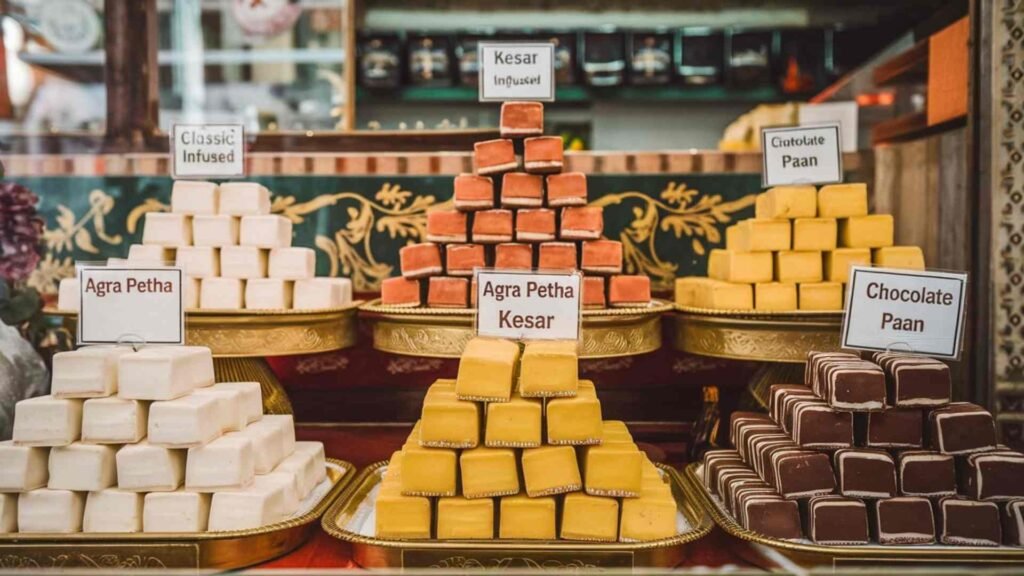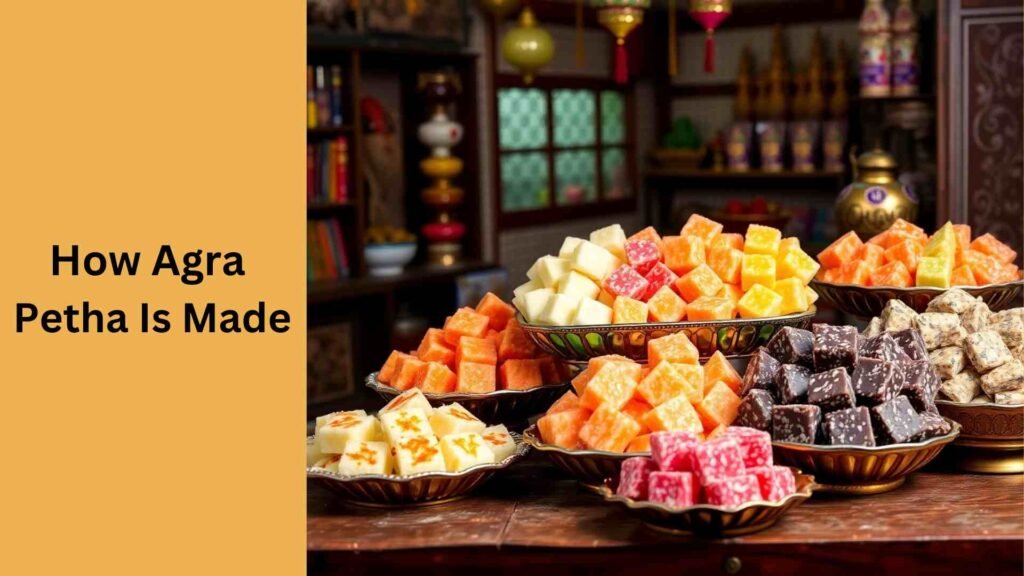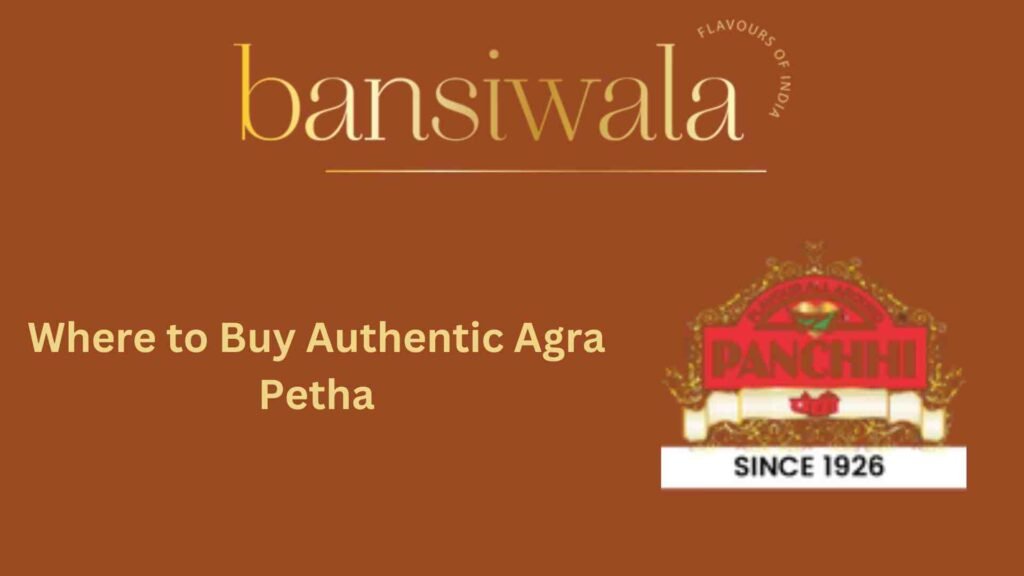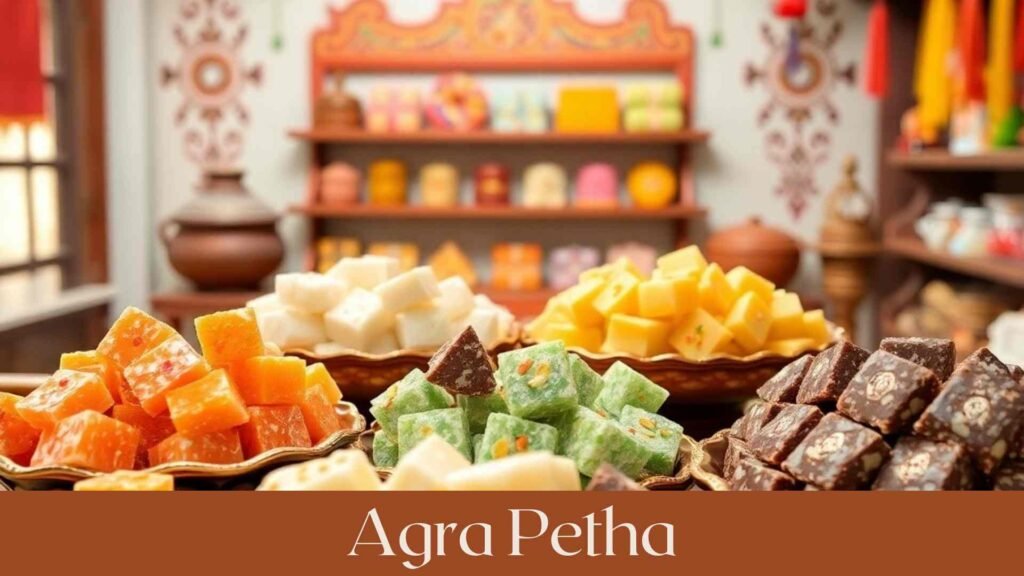Agra Petha, a renowned sweet delicacy, has been a part of Indian cuisine for centuries. Famous for its translucent appearance, chewy texture, and delightful taste, this dessert holds a special place in the hearts of sweet lovers.
Originating from Agra, Uttar Pradesh, it has become synonymous with the city’s culinary identity and is now enjoyed across the globe in various flavors and styles.
The Origins of Agra Petha

The story of Agra Petha is as intriguing as its taste. While there is a popular legend attributing its origin to the Mughal era during Shah Jahan’s reign, historical evidence suggests that similar dishes existed in the subcontinent even before the Mughals arrived.
References to sweets resembling Petha, known as Oal or Oal ka Murabba, have been found in regions like modern-day Jharkhand and Bihar.
However, Agra’s version of Petha gained prominence due to its unique preparation and connection to the Taj Mahal city.
The sweet was traditionally made using ash gourd, also known as white pumpkin, which is boiled, cured in lime water, and soaked in sugar syrup to create its signature texture and flavor.
What Makes Agra Petha Special?
Agra-Petha stands out for its simplicity and versatility. Made with just a handful of ingredients—ash gourd, sugar, and water—it transforms into a delectable treat that is both sweet and refreshing.
Its chewy yet moist texture, subtle sweetness, and delightful flavors make it a favorite among all age groups.
The confection is also known for its ability to adapt to new flavors and styles, giving rise to a variety of modern-day innovations while retaining its traditional charm.
Popular Variants of Agra Petha
Classic Petha: The traditional version that highlights the natural sweetness of ash gourd.
Kesar Petha: Infused with saffron for a luxurious aroma and flavor.
Angoori Petha: Bite-sized versions often enjoyed as a quick snack.
Chocolate Petha: A contemporary twist, blending the rich taste of chocolate with the classic recipe.
Paan Petha: Flavored with betel leaves and spices, offering a unique Indian aftertaste.
Coconut Petha: Enhanced with shredded coconut for an added layer of texture and flavor.
How Agra Petha Is Made

The process of making Agra-Petha is a perfect blend of tradition and technique. The key steps include:
- Preparation of Ash Gourd: The gourd is peeled, seeded, and cut into bite-sized pieces.
- Curing: These pieces are soaked in lime water for a few hours to achieve the right texture.
- Cooking: The cured pieces are boiled until soft and then simmered in sugar syrup.
- Flavoring: Depending on the variant, additional ingredients like saffron, kewra essence, or chocolate are added during the final stages.
The result is a translucent, sugary treat with a chewy, crystalline texture that melts in your mouth.
Why Agra Petha Is Loved by All
Agra-Petha is more than just a dessert—it’s a cultural icon that embodies the rich culinary heritage of India. Its widespread popularity stems from:
- Authenticity: Handmade with traditional recipes passed down through generations.
- Variety: A flavor for every palate, from the classic to the experimental.
- Health Benefits: Low in fat and made with natural ingredients, making it a guilt-free indulgence.
- Perfect for Gifting: A symbol of hospitality and celebration, often gifted during festivals and special occasions.
Where to Buy Authentic Agra Petha

If you’re visiting Agra, the bustling sweet shops of the city, such as Panchhi Petha and Bansiwala, are a must-visit for authentic, flavorful, and high-quality treats.
These stores offer a wide selection of Petha, including classic and innovative flavors, all crafted with high-quality ingredients. For those unable to visit in person, online platforms provide convenient access to this iconic sweet.
Recommendations from Top Stores
- Bansiwala: Known for varieties like Chocolate Petha, Kesar Petha, and Assorted Festive Packs.
- Panchhi Petha: Offers unique options such as Rose Angoori Petha, Coconut Petha, and Lal Petha.
Conclusion
In conclusion, Agra Petha is more than just a sweet; it’s a symbol of Agra’s rich cultural heritage and culinary innovation.
Whether you’re indulging in the classic version or exploring the unique flavored varieties, each bite offers a taste of tradition and craftsmanship.
With its vibrant colors, chewy texture, and sweet syrup, Agra Petha continues to captivate locals and tourists alike. So, next time you find yourself in Agra, don’t miss the opportunity to savor this iconic treat—whether from famous shops like Bansiwala or Panchhi Petha, it’s sure to leave you with a memorable taste of the city’s sweet legacy.
Looking for more great reads? Check out our homepage maxxfour.in for trending articles and insightful blog posts on various topics.
FAQs
What is Agra Petha made of?
Agra-Petha is made from ash gourd, sugar, and water, with variations including ingredients like saffron, coconut, or chocolate for added flavor.
Is Agra Petha healthy?
While it is a sweet treat, Agra-Petha is low in fat and made with natural ingredients, making it a healthier dessert option compared to heavily processed sweets.
How should Agra Petha be stored?
Agra-Petha should be stored in an airtight container at room temperature. Refrigeration is recommended for longer shelf life, especially for moist variants.
Can I buy Agra Petha online?
Yes, several renowned stores like Panchhi Petha and Bansiwala offer online shopping options, making it easy to order authentic Agra-Petha from anywhere.
Are there vegan options available for Agra Petha?
Most variants of Agra-Petha are naturally vegan as they do not contain dairy or animal-based ingredients.
What are the most popular flavors of Agra Petha?
Some of the most loved flavors include Kesar Petha,







